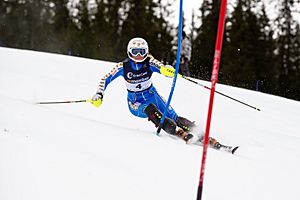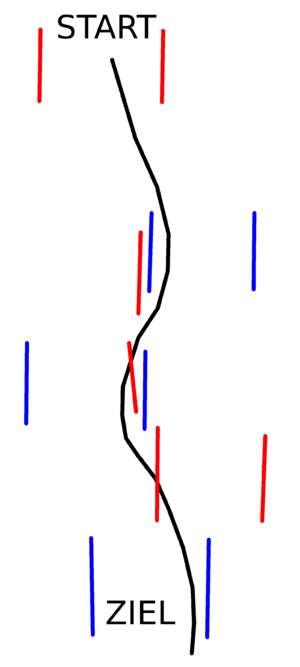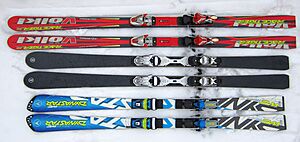Slalom skiing facts for kids
Slalom is an exciting winter sport where skiers or snowboarders race down a snowy hill. They have to ski between special poles called "gates." These gates are placed closer together than in other races like giant slalom or downhill. This means skiers need to make very quick, short turns to get through the course.
You can see slalom competitions at big events like the FIS Alpine World Ski Championships and the Olympic Winter Games.
Contents
What is Slalom?
The Name's History
The word "slalom" comes from an old Norwegian word, "slalåm." "Sla" means a "slightly sloping hillside," and "låm" means a "track made by skis."
Long ago, the people who invented modern skiing gave names to their trails based on how hard they were. A "slalåm" was a trail for younger skiers who weren't ready for the really tough runs yet. There were also "ufsilåm" (a trail with one obstacle like a jump) and "uvyrdslåm" (a trail with many obstacles).
In 1767, a Norwegian army ski race even included skiing downhill through trees without falling! Later, skiers like Sondre Norheim practiced "uvyrdslåm" by racing down difficult, untouched snowy areas.
The first "ski race" in Oslo in 1866 included cross-country skiing, jumping, and slalom. In the slalom part, skiers could use poles to slow down and steer. They even got points for how good their skiing looked!
Modern Slalom Rules
The rules we use for modern slalom races were created by Arnold Lunn in 1922 for the British National Ski Championships. These rules were later used in the alpine skiing at the 1936 Winter Olympics.
Under these rules, gates are marked by two flags instead of just one. The gates are set up so skiers have to make different kinds of turns. Also, the winner is decided only by the fastest time, not by how stylish their skiing is.
The Slalom Course
A slalom course is made by setting up many gates. Each gate is formed by two poles, one red and one blue, placed one after the other. Skiers must pass between these two poles. Both their ski tips and their feet must go between the poles.
A men's course usually has between 55 and 75 gates, while a women's course has 40 to 60 gates. The course drops about 180 to 220 meters (about 590 to 720 feet) for men, and a bit less for women. The gates are arranged in many different ways to make the race challenging for the skiers.
Because the gates are so close, skiers often take a very straight path. They even knock the poles out of the way as they go! This is called "blocking." One common blocking method is "cross-blocking." Here, the skier leans so much that they hit the gate with their outside hand, pushing it down. To stay safe, racers wear special gear like shin pads, hand guards, helmets, and face guards.
How Skiers Clear the Gates
In the past, slalom gates were made of stiff bamboo poles. This meant skiers had to move their whole body around each gate. But in the early 1980s, these stiff poles were replaced with plastic poles that could bend at the bottom.
These new hinged gates changed the sport. Now, according to the rules, only the skier's skis and boots need to go around each gate.
The hinged gates allow skiers to take a more direct path down the course. They do this by using a technique called "cross-blocking" or "shinning the gates." In cross-blocking, skiers lean their upper body over or even across the gate. Their outside pole and shin guards hit the gate, knocking it down and out of the way. Skiers can push the gate down with their arms, hands, or shins. By 1989, most top skiers were using this cross-blocking method.
Ski Equipment
Around the year 2000, skis changed a lot with the invention of "shaped skis." This greatly affected the equipment used in slalom races. In the 1980s and 1990s, professional skiers used slalom skis that were about 203 to 207 centimeters (about 80 to 81 inches) long. But by the 2002 Olympic Winter Games, most skiers were using much shorter skis, around 160 cm (63 inches) or less.
However, these shorter skis made it harder for skiers to recover if they lost their balance. To keep athletes safe, the FIS (the main organization for ski sports) started setting minimum ski lengths for international slalom races. At first, the minimum was 155 cm (61 inches) for men and 150 cm (59 inches) for women. But for the 2003–2004 season, it was increased to 165 cm (65 inches) for men and 155 cm (61 inches) for women.
Some skiers, equipment makers, and fans were not happy about these new rules. They felt that the FIS was making the equipment, and therefore the sport, go backward in time.
American skier Bode Miller helped speed up the change to shorter, more curved skis. He had unexpected success after being one of the first young athletes to use this new equipment in giant slalom and super-G races in 1996. A few years later, this technology was also used for slalom skis.
Images for kids
See also
 In Spanish: Slalom para niños
In Spanish: Slalom para niños









